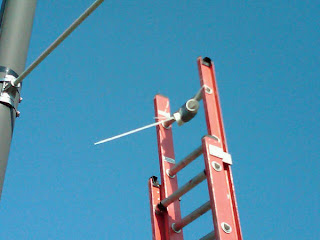I used to travel with this raggedy carry on suitcase for the site survey gear, until I invested in a proper suitcase that can hold the survey kit on one side and a week's worth of my clothes on the other side..
Old Raggedy Suitcase
 New Suitcase Hotness
New Suitcase Hotness
This is my suitcase when it is fully loaded with 2 Tessco battery packs, all necessary mounting equipment and a Cisco 1142 access point.
Over the years I've had to come up with all kinds of site survey mounting solutions for the Cisco 1240, 1130 and 1140 access points. Luckily the 1130 and 1140 have similar mounting fixtures, and what has worked for the 1130 easily works for the 1140.
For my first survey with a 1240, the customer wanted to ceiling mount the ap and use the AIR-ANT4941 dipole antennas, so I rigged up a wire harness to the back of the 1240 using phone wire. I used the suspended ceiling clips that come with the 1240 to rig up a hook to hang the ap from the suspended ceiling grid while I was surveying. Luckily the customer had some heavy duty wire, pliers and duct tape that I could use/borrow. Flying to a customer site leaves you pretty unprepared to rig something up since you can't carry any tools with you.
This is a rig I made for the 1240 ap out of a couple of coat hangers and some clear tape.
This rig allows me to hang the 1240 off of a Wooster Wide Boy attachment (found at Lowe's) at the top of a Mr. Longarm (found at Home Depot) painters pole. From there the external antennas can be duct taped to the arms of the Wooster.
I don't have a picture of the survey cart all setup with a 1240 survey rig attached, but it looks something like this when it is all assembled.
Coming up with a mounting solution for the 1130/1140 was a bit trickier since the ap is installed horizontally. I got the idea from a friend who works for Cisco Advanced Services. He uses a PVC floor scrubber attachment with the bristles removed, and the edges ground down to allow the attachment of the 1140 mounting bracket.
I don't have a dremel to grind the PVC, so I opted for a wooden drywall tool attachment with the bristles removed for my survey rig. The two angled adapters are used to put the 1130/1140 at the right angle for surveying.
Using items found at any Home Depot make traveling to the survey location much easier. The only tools I need to get before arriving at the customer location is the Mr. Longarm and a fairly sturdy dowel rod. I use the dowel rod to apply the ap number sticker to the suspended ceiling grid (with the help of a little tape). I don't need a ladder if I have the dowel rod.
As long as I can use some sort of rolling cart at the customer site, the painter's pole survey rig will work. Most recently I used a furniture trolley as a survey cart. Once when a cart wasn't available, I've even had to use a waiting room chair as a support for the painter's pole.
Of course, the most insane thing I've done is climb a 20 foot ladder that was being stabilized by an enormous PVC elbow attached to the top of the ladder. Never again.
If you had to come up with a unique rig job so you can keep working, I'd love to hear about it.. let's not all reinvent the wheel eh?














